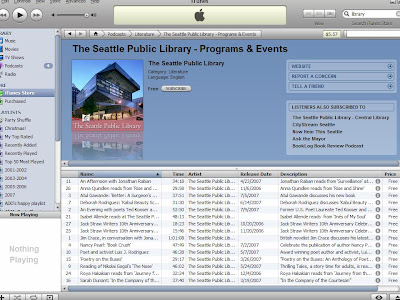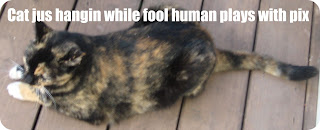 Laura Cohen’s posting, A Librarian's 2.0 Manifesto is a good tool for regaining perspective whenever I feel myself sliding into the “I’m never going to learn this @#$%^ stuff” mindset that often accompanies the uphill climb part of the learning curve for me.
Laura Cohen’s posting, A Librarian's 2.0 Manifesto is a good tool for regaining perspective whenever I feel myself sliding into the “I’m never going to learn this @#$%^ stuff” mindset that often accompanies the uphill climb part of the learning curve for me.
One of the great references from the Wikipedia on “Library 2.0” entry was "The Long Tail" by Chris Anderson, Wired, Oct. 2004 because it explained the comparative advantage that Amazon.com has over retail booksellers and how it can be economically viable. By making available a huge variety of titles it can afford to a few copies of less popular titles, because collectively it sells more of them than its best sellers. But it’s also a warning to libraries that we cannot, as individual institutions, compete with the scope of the online bookseller.
I had an interesting reaction to the five articles OCLC posted in 2006 about “Where the next generation Web will take libraries, Away from Icebergs, Into a new world of librarianship, To more powerful ways to cooperate, To better bibliographic services, To a temporary place in time.”
My reaction was this is all old news. It’s like the authors rediscovered what Ranganathan first published in 1931 (Ranganathan, S. R. (1931) The Five Laws of Library Science. Madras Library Association (Madras, India) and Edward Goldston (London, UK). To me most of it just seems a restatement of law # 5 “A Library is a Growing Organism.”
“It is an accepted biological fact that a growing organism alone will survive. An organism which ceases to grow will petrify and perish. The fifth law invites our attention to the fact that the library, as an institution, has all the attributes of a growing organism. A growing organism takes in new matter, casts off old matter, changes in size and takes new shapes and forms.”
At the same time, the OCLC authors seem to have overlooked what I think is the significant difference that the Internet has made on the library. We have become a center for two-way communication and learning for our customers. Before the Internet we were a place for one-way communication and learning. With a book, a remote or inaccessible author communicated with a reader. The reader’s imagination stimulated by the author’s words or pictures had a new experience and had something new to think about. There was very little dialog between author and reader. Occasionally, a reader might write a letter via the author’s publisher to a living author, or, more publicly, write a letter to the editor of a newspaper, but these were infrequent occurrences and the library, as an institution, was a bystander.
In the final decades of the twentieth century all that changed. Rather than face extinction we reinvented ourselves. To put it in Ranganathan’s terms, our organism grew. Seeing and hearing of new ways to transmit and receive information we acquired, as rapidly as our budgets allowed, the new technologies that enabled us and our readers to take advantage of this new technology. Suddenly tiny branch libraries could have magazine and reference collections to rival those of much larger facilities. It was a sudden metamorphoses rather than the slow continuous change of evolution to which we were accustomed.
At first, I’m not sure we fully understood how significant interactivity was going to change how we did business. We just looked at it as a wonderful new way to get more resources, a way to supplement the book collection. The collection would grow and we wouldn’t have to find a place to store it. It was even more gee-whiz than inter-library loan. Yes, we’d read that e-mail was the most popular of the three uses of the Internet, but what really excited us were the possibilities offered by remote logon and file transfer protocol. Real, live computer information -- right here in your local public library. We could provide more things for people to read and view.
So we were ready for the crowds that came flocking to the library to take advantage of our new and authoritative databases. We would be there to guide them, as always, but now they didn’t have to go through us to get information out of DIALOG. With more self-service we’d be able to help more people.
They flocked in, but they didn’t want our help to get information out of DIALOG or most of the databases to which we had purchased access. And they stopped asking us for the population of Pakistan or who there senators were in Washington or Austin. Instead those that were computer-savvy wanted to know why the color printer for the computer wasn’t working and when were we going to get it fixed, or those who weren’t computer-savvy wanted to know why the keys on the keyboard weren’t in alphabetical order? They didn’t particularly want help finding information as we had been providing it for decades. We were disintermediated! We were dissed! And after all we’d done for them. We felt a little hurt. We had to work on our feelings of rejection.
They did, however, very much want us to teach them how to use the computers. We reinvented ourselves as instructors and teachers. This was a somewhat difficult transition for those librarians who had become librarians because earlier in life they’d discovered that they really didn’t like the classroom. But we got over that, mostly.
They scorned our expensive databases and cruised about the Internet for items of doubtful authenticity or, worse, titillating pictures that seemed designed to annoy other customers. They played checkers with people in another state. They watched movies and listened to music. They even found the lyrics to popular songs. Once again, the most popular searches were for those that seemed designed to annoy other customers.
But, most of all, they wanted to check their hotmail, or they wanted us to fix the hotmail if it wasn’t working. The first wave of digital natives came in, took up all of the available computers, got into MUDs (multi-user dungeons or domains) and played MMORPGs (massive multiplayer online role-playing games) all afternoon, much to the annoyance of their elders who had to type a resume for heaven’s sake! In other words, they came in the library to communicate. We had become a center for two-way communication and learning.
And the library had become one of the places to do it. We had become the much-desired third place, the not-home, not work-or-school place that we had always wanted to be. A side effect was that we had become at all hours just as noisy as we were right after story time let out. Contrary to the expectations of many, instead of withering away the Internet made us flourish. Not everyone was amused. Not everyone is happy with the new arrangement. It’s not perfect, but then, it never was.
For more about the man who invented Library Science:
http://w3.uniroma1.it/vrd/mathematics/i-ranganathan.html
http://www.slais.ubc.ca/courses/libr517/03-04-wt2/projects/ranganathan/index.htm
and his continued relevance:
Noruzi, Alireza (2004) Application of Ranganathan's Laws to the Web. Webology 1(2).



























 That small gripe aside the popular blogs did link me to other blogs like A Library By Any Other Name
That small gripe aside the popular blogs did link me to other blogs like A Library By Any Other Name 










